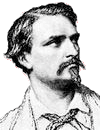
![]() Mistral
was a Provençal
Poet who led the 19th-century revival of Occitan
language and literature. (Provençal
is a dialect of the Occitan
language, but confusingly the name is sometimes used as
a synonyme for Occitan)
Mistral
was a Provençal
Poet who led the 19th-century revival of Occitan
language and literature. (Provençal
is a dialect of the Occitan
language, but confusingly the name is sometimes used as
a synonyme for Occitan)
Mistral's father was a farmer near to Maillane, Bouches-du-Rhône département, Provence, just south of Avignon, east of the River Rhône and northeast of the Camargue. Frédéric attended the Royal College at Avignon (now called the Frederic Mistral School). He took a degree in law at the University of Aix-en-Provence in 1851.
Wealthy enough to survive without working for a living, he decided early on to devote himself to the rehabilitation of Provençal life and language.

![]() Frédéric
Mistral and six others (Joseph Roumanille, Théodore
Aubanel, Jean Brunet, Paul Giéra, Anselme Mathieu
and Alphonse Tavan) together founded the félibrige
(Felibrige), an association for the maintenance of the Provençal
language and customs. It was created on 21 May 1854, at
Châteauneuf-de-Gadagne (Vaucluse). The word félibrige
is derived from félibre, a Provençal
word meaning pupil or follower. The scope was later extended
later to include the whole of the Midi - what is now southern
France. Their device, as on the flag shown on the right
is clearly based on the Cross
of Toulouse. The connection is that the various dialects
of Occitan are spoken in Occitania,
and Occitania is almost identical with the ancient territories
of the The
Counts of Toulouse and their allies - basically the
whole of what is now the South of France; and the heraldic
device of the Counts of Toulouse was the Cross of Toulouse.
The seven pointed star represents the seven founders.
Frédéric
Mistral and six others (Joseph Roumanille, Théodore
Aubanel, Jean Brunet, Paul Giéra, Anselme Mathieu
and Alphonse Tavan) together founded the félibrige
(Felibrige), an association for the maintenance of the Provençal
language and customs. It was created on 21 May 1854, at
Châteauneuf-de-Gadagne (Vaucluse). The word félibrige
is derived from félibre, a Provençal
word meaning pupil or follower. The scope was later extended
later to include the whole of the Midi - what is now southern
France. Their device, as on the flag shown on the right
is clearly based on the Cross
of Toulouse. The connection is that the various dialects
of Occitan are spoken in Occitania,
and Occitania is almost identical with the ancient territories
of the The
Counts of Toulouse and their allies - basically the
whole of what is now the South of France; and the heraldic
device of the Counts of Toulouse was the Cross of Toulouse.
The seven pointed star represents the seven founders.
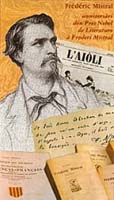
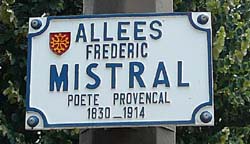
![]()
![]() Occitan,
the language of the troubadours,
had been the cultured speech of the Midi - what is now southern
France plus parts of modern Italy and Spain.
Occitan,
the language of the troubadours,
had been the cultured speech of the Midi - what is now southern
France plus parts of modern Italy and Spain.
The Félibrige survives as a literary and cultural association. In 1876, the society formalised its organisation and programme for a "Provençal revival" throughout the regions of Provence, Lanquedoc, and Aquitaine and the Spanish province of Catalonia.
In 1892 a group of its members, headed by Frederick Amouretti and Charles Maurras, put forward a demand for Provençal autonomy within a federalized France.
|
The adjoining pictures shows a photograph of a plaque set up be the Mayor of Toulouse. It is an extract from an Occitan poem of Mistral. It reads: To living Toulouse,
to Toulouse who sings Oh! Keep thine historic tongue ...
It is the proof The extract is from A Na Clemenço Isauro, first recited on 3rd March 1879 at the Capitole of Toulouse during the Jeux Floraux of that year. |
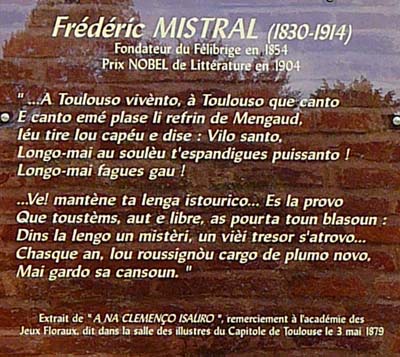 |

![]() Mistral
devoted 20 years' work to a scholarly dictionary of Provençal,
entitled Lou Tresor dou Felibrige, 2 vol. (1878).
He also founded a Provençal ethnographic museum in
Arles. His poetic genius gave Occitan some enduring modern
masterpieces, and today he is considered one of the greatest
poets of France.
Mistral
devoted 20 years' work to a scholarly dictionary of Provençal,
entitled Lou Tresor dou Felibrige, 2 vol. (1878).
He also founded a Provençal ethnographic museum in
Arles. His poetic genius gave Occitan some enduring modern
masterpieces, and today he is considered one of the greatest
poets of France.
He was instrumental in reviving the Occitan part of the Jeux Floraux, the oldest literary competition in the world, now held each year in Toulouse. (The Collège de la gaie science had originally been founded in or around 1323 at Toulouse by seven troubadours to uphold the traditions of courtly lyricism).
His literary output includes four long narrative poems:
Mireio (1859;  Mireio: A Provençal Poem), Calendau (1867),
Nerto (1884), and Lou Pouemo dou Rose (1897;
Mireio: A Provençal Poem), Calendau (1867),
Nerto (1884), and Lou Pouemo dou Rose (1897;
 The
Song of the Rhone); a historical tragedy, La Reino
Jano (1890;
The
Song of the Rhone); a historical tragedy, La Reino
Jano (1890;  "Queen Jane"); two volumes of lyrics, Lis
Isclo d'or (1876 & 1889) and Lis Oulivado
(1912); and many short stories, collected in Prose d'Armana,
3 volumes (1926-29). His main claim to fame rests on his
first and last long poems, Mireio and Lou Pouemo
dou Rose, both full-scale epics in 12 cantos.
"Queen Jane"); two volumes of lyrics, Lis
Isclo d'or (1876 & 1889) and Lis Oulivado
(1912); and many short stories, collected in Prose d'Armana,
3 volumes (1926-29). His main claim to fame rests on his
first and last long poems, Mireio and Lou Pouemo
dou Rose, both full-scale epics in 12 cantos.
|
Mireio, is set in Mistral's own time and district. It is the story of the daughter of a rich farmer, whose love for the son of a poor basketmaker is thwarted by her parents. It ends with her death in the Church of Les Saintes-Maries-de-la-Mer. Mistral expressed his love for the countryside where he was born into this poem. He skillfully combines narration, dialogue, description, and lyricism and is notable for the musical quality of its stanzaic form. It inspired an opera by Charles Gounod Mireille (1863) - the name Mireille being the French form of Mireio . |
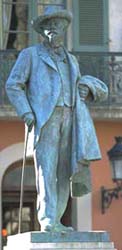 |
Lou Pouemo dou Rose tells of a voyage down the Rhone River from Lyon to Beaucaire of a barge called Lou Caburle. The vessel is boarded by a romantic young prince of Holland and by the daughter of a poor ferryman. The romance between them is cut short disaster when the first steamboat on the Rhône river sinks Lou Caburle. The crew swim ashore but the two lovers are drowned. This epic is as full of life and colour. It has been suggested that the story reflectys that Mistral, late in life, realized that Occitan and the Provençal culture was, like his hero and heroine, doomed to perish. |
|
Today, Mistral's volume of memoirs, Moun espelido
( In 1904 he shared the Nobel Prize for Literature for his contributions in literature and philology. He used his Nobel Prize money to found his Provençal ethnographic museum in Arles. He continued to be the guiding spirit and chief organiser of the Felibrige movement until his death in 1914. |
Trivia
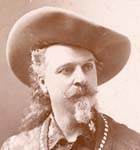
 Mistral
had many admirers, including William Cody (Buffalo Bill
- shown right) who came to visit him and left him his dog
as a present. One wonders if Cody copied Misatral's distinctive
beard - they look uncannily similar. In any case Cody must
have conveyed his enthusiam for the poet to his Indian colleagues.
A few years later a party of Sioux came to visit him too.
Today, Mistral's house is a museum dedicated to him, and
you can still see a bow and arrows that the Sioux brought
as presents.
Mistral
had many admirers, including William Cody (Buffalo Bill
- shown right) who came to visit him and left him his dog
as a present. One wonders if Cody copied Misatral's distinctive
beard - they look uncannily similar. In any case Cody must
have conveyed his enthusiam for the poet to his Indian colleagues.
A few years later a party of Sioux came to visit him too.
Today, Mistral's house is a museum dedicated to him, and
you can still see a bow and arrows that the Sioux brought
as presents.
Serendipitously, his surname is also the name ofthe Mistral wind famous in the area of his birth.
|
Tolosa!
|
 Mes origines mémoires et récits,
1906;
Mes origines mémoires et récits,
1906; 




